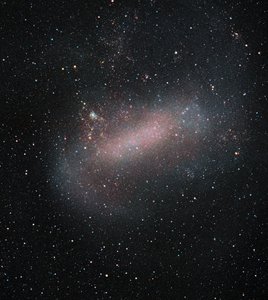A new, spectacular view of the Large Magellanic Cloud
The VISTA survey of the Magellanic Clouds, led by Maria-Rosa Cioni of the Leibniz Institute for Astrophysics Potsdam (AIP), reveals a remarkable new image of the Large Magellanic Cloud. The telescope, part of ESO’s Paranal observatory, has been surveying this galaxy and its sibling, the Small Magellanic Cloud, as well as their surroundings, in unprecedented detail for the last decade.
The Large Magellanic Cloud is one of our nearest galactic neighbors, at only 163 000 light years from Earth. With the Small Magellanic Cloud, these are among the nearest dwarf satellite galaxies to the Milky Way. The Large Magellanic Cloud is also the home of various stellar conglomerates and is an ideal laboratory for astronomers to study the processes that shape galaxies.
ESO’s VISTA telescope has been observing these two galaxies for the last decade. The main goal of the VISTA Magellanic Clouds Survey has been to map the star formation history of the Large and Small Magellanic Clouds, as well as their three-dimensional structures. “Our section is leading the VISTA survey of the Magellanic Clouds system and has been awarded an ERC consolidator grant for using the Magellanic Clouds to study the interaction of galaxies,” states Maria-Rosa Cioni, head of the Dwarf galaxies and the Galactic Halo section at AIP and principle investigator of the survey.
VISTA was key to this image because it observes the sky in near-infrared wavelengths of light. This allows it to see through clouds of dust that obscure parts of the galaxy. These clouds block a large portion of visible light but are transparent at the longer wavelengths VISTA was built to observe. As a result, many more of the individual stars populating the centre of the galaxy are clearly visible. Astronomers analysed about 10 million individual stars in the Large Magellanic Cloud in detail and determined their ages using cutting-edge stellar models. They found that younger stars trace multiple spiral arms in this galaxy.
For millennia, the Magellanic Clouds have fascinated people in the Southern Hemisphere, but they were largely unknown to Europeans until the 16th century. The name we use today harkens back to Ferdinand Magellan, who 500 years ago began the first circumnavigation of the Earth. The records the expedition brought back to Europe revealed many places and new knowledge to Europeans for the first time. The spirit of exploration and scientific curiosity is ever more live today in the work of astronomers around the world, including the VMC team whose observations led to this stunning image of the Large Magellanic Cloud.
Images
The Large Magellanic Cloud revealed by VISTA.
Big screen size [1000 x 1117, 320 KB]
Original size [1280 x 1430, 570 KB]
These cutouts highlight some of the most spectacular regions in the Large Magellanic Cloud.
Big screen size [1000 x 1000, 390 KB]
Original size [1280 x 1280, 660 KB]





